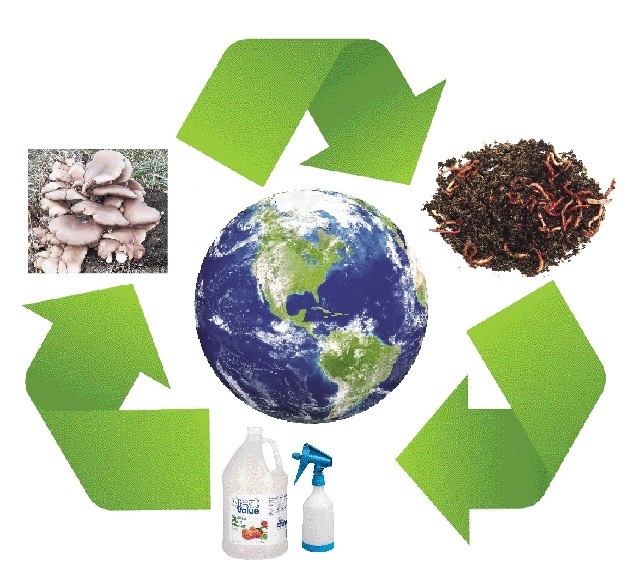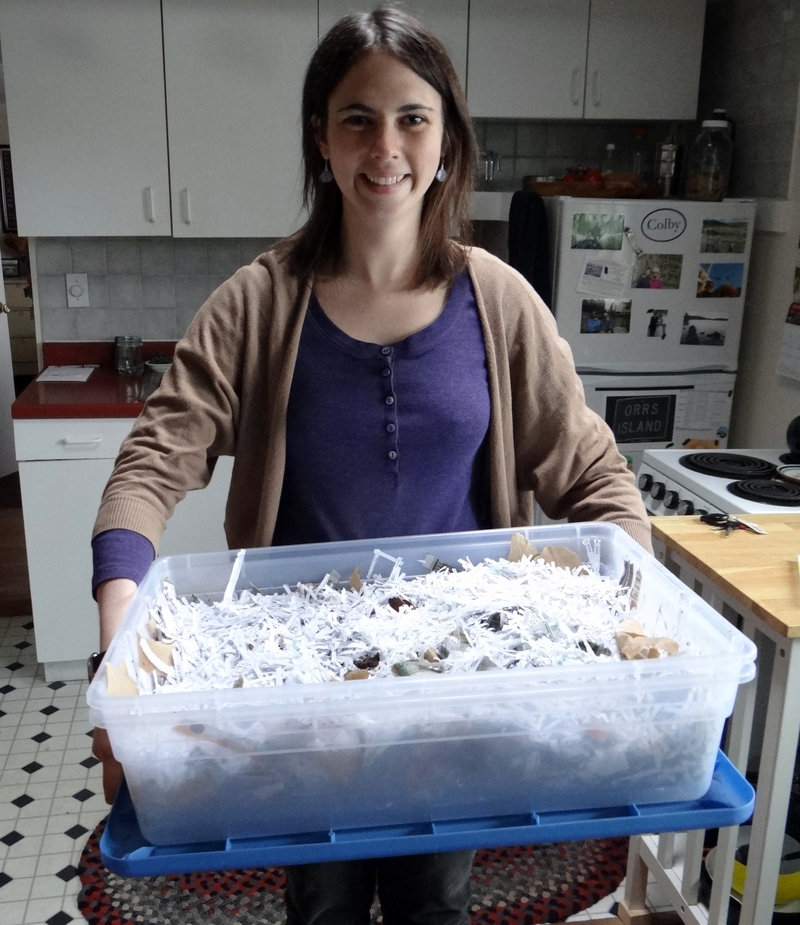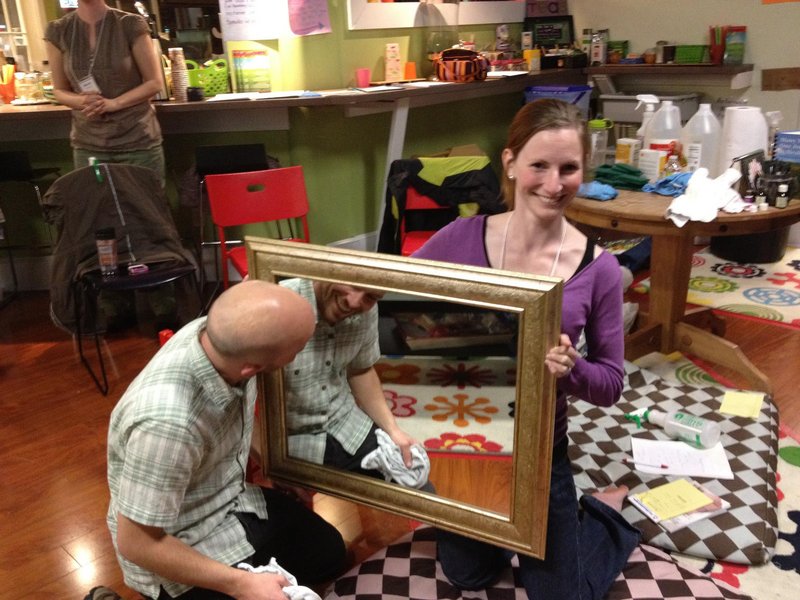Meredith Wood-Masteka and her husband care about the environment.
But they both work full time and have two children, so running a completely Earth-friendly household can be a challenge.
Still, they do what they can. They both drive older cars. They go to local farmers’ markets so they can buy fresh foods that haven’t traveled 500 miles to get here. This year, they’ll be growing some of their own food in raised beds.
The couple shops at secondhand stores for children’s clothing, and stocks up on children’s books at summer library sales.
Instead of upgrading to a larger home in the suburbs, they have stayed in a smaller home in Portland. It’s cheaper to heat, and they don’t have a long commute to their jobs. They use a green cleaning service to clean their home so they aren’t exposed to toxic chemicals.
Sometimes, they have to make compromises. Wood-Masteka would like to use cloth diapers, “but I just don’t quite have the energy to do it.”
“I’m still using disposable, but at least they don’t have bleach and they’re chlorine-free,” she said. “So it’s a bit of a baby step. Whether it be from a financial standpoint or a time standpoint, if you can’t go all the way, it doesn’t mean you can’t do something.”
Today is Earth Day, and lots of families will be thinking about ways they could make their lives a little more environmentally friendly.
The steps that make the biggest difference are actions that revolve around transportation and energy, says Judy Berk of the Natural Resources Council of Maine. That means walking, carpooling or biking to work instead of driving. Or making your house more energy efficient.
But if you don’t have the money right now to do a major energy overhaul, there are lots of smaller things people can do around the house to make a change and shift their way of living.
Joe Walsh, owner of Green Clean Maine, a cleaning business that uses only environmentally friendly cleaners, said there’s “just more and more demand all the time.”
Walsh said his business has been growing 50 percent year over year. Most of his customers just don’t have the time to do the cleaning themselves, he said, but when he goes into homes to do an estimate, he finds people are much more educated about the issues than they used to be.
“More and more people are coming to me already educated about the dangers of traditional cleaning products and the benefits of cleaning without them,” he said. “I’ve been impressed by that.”
Earlier this month, Walsh was asked to speak at a meeting of the Holistic Moms Network. The Portland chapter, one of 120 chapters across the country, started two years ago and has 22 members. New members arrive every month to their meetings, where they invite experts to talk about different topics on holistic health or “green living.”
Julie Wagner, who leads the group, says everyone in the group is on their own path, “but everybody is interested in changing up their life and taking small steps toward a greener lifestyle.”
“If you think overall about holistic living or living green, it can be really, really overwhelming to think about that perfect place, whatever that might be, because it’s different for every person,” Wagner said. “I only have two children. My friend has five. So what she expects in her house and her family, and how she expects to live green is different than what I expect about how to live green.
“We make different choices. And I think that’s the key to what Holistic Moms is about. It’s about making baby steps, because when you make those small changes, they’re easier to hang onto. They’re more manageable.”
So what are some easy things homeowners can do to make their lives more environmentally friendly? Here are a few ideas:
WORM COMPOSTING
Emmie Theberge of Augusta is the clean energy and global warming outreach coordinator for the Natural Resources Council of Maine. So every time she had to throw out food scraps at home, she felt really guilty, because she knew they would end up in a landfill or being incinerated rather than being recycled in some way.
But she lives in a small apartment with no backyard, so backyard composting was out of the question.
Then a friend told her about worm composting. Now she keeps a bin filled with red worms and shredded paper under her kitchen counter. and when she has a piece of sandwich or an apple core left over from dinner, she just tosses it in.
“There’s really almost no smell with the worm bin,” Theberge said, “and so instead of having your food scraps sit in your trash bin for however long it is before you take the trash out, smelling or having flies in the summer, it’s out of the way and doesn’t smell.”
Theberge borrowed a book on the topic from a friend and also researched the project online. One of the best websites that explains how to do it, she said, is WikiHow (wikihow.com/Make-Your-Own-Worm-Compost-System).
Theberge filled her bin with a coffee can full of worms her friend gave her — you can also order them online — then topped it off with damp, shredded paper. Every time she feeds the worms, she simply moves the paper aside and tosses the food in. She feeds her worms about once a week, but says you could throw food in every day if you want.
Theberge even keeps a bowl at work for lunch scraps and brings it home weekly to use as worm food.
Worried about worms crawling around your kitchen? Theberge said they will stay at the bottom of the bin “as long as they’re happy.” Worms crawling around the lid of the bin is an indication something is wrong.
“You’re either not feeding them enough, or maybe it’s too dry,” she said.
The compost the worms make can be used on home gardens, or even indoor houseplants.
The Holistic Moms Network had someone speak to the group on this topic recently, and now many of the moms are trying it.
“That’s one thing that a lot of people have started, because they learned how easy it is,” Wagner said. “You can have it in your basement or your garage.”
Meredith Wood-Masteka is also considering starting a worm bin after her 4-year-old learned how to do it in pre-school.
“I think he’s talked me into it for this year, if I can get past the whole worms in my kitchen thing,” she said.
GREEN CLEANING
Here are Walsh’s top five tips for cleaning your home in an environmentally friendly way:
1. Change your hand dish detergent to a product that uses plant-based surfactants instead of petrochemicals.
Be sure to check the labels, even on products that are labeled green or all-natural.
“I tell people, only buy products that disclose all ingredients,” he said. “That’s a huge litmus test.”
2. Make your own streak-free, multipurpose surface cleaner. Traditional cleaners contain solvents with neurotoxins and hormone disrupters, according to Walsh, and they probably also contain ammonia. Instead, mix up this cleaner in two minutes and put it in your own spray bottle:
1/8 to 1/4 teaspoon plant-based dish detergent. Use less if it’s really sudsy, more if the water is beading on the glass.
1/2 cup vinegar
2 cups water
“It takes the place of your bathroom cleaner, your window cleaner, your spraying and wiping up a spot on floor,” Walsh said. “That’s a great first one to try out. I just keep a bottle in the kitchen and use it for cleaning up after dinner and stuff like that. It’s a good multipurpose starter (cleaner).”
3. Make a grease-cutting cleaner with baking soda to tackle food stains, kids’ fingerprints, oils from pet hair and stovetops. This recipe is also a great deodorizer. Combine the ingredients in a spray bottle, and wipe clean with a cloth or sponge.
1/2 teaspoon plant-based detergent
2 teaspoons baking soda
2 1/2 cups water
4. To remove stains on countertops or sinks, instead of using bleach, put baking soda in an old Parmesan cheese container. Sprinkle 1 to 2 tablespoons of baking soda on the surface, then spray it with water (or the grease-cutting solution above) until it is the consistency of toothpaste. Scrub with a sponge or light-duty scrubbing pad, then rinse with water. It’s the natural alternative to products like Magic Eraser.
“It will whiten and remove staining from anything,” Walsh said.
5. Got a clogged drain? Go to the hardware store, Walsh suggests, and buy a drain plunger, “which people forget exists. It basically looks like a toilet plunger, but it’s small.”
Another option is to pour baking soda down the drain, then add distilled white vinegar and cover the drain. The fizzing action will clear the drain or speed up a slow drain. It’s the same thing you did when you built a volcano at the science fair when you were a kid.
“People love this because it’s fun to do,” Walsh said.
REPAIR OLD FURNITURE
The Environmental Protection Agency estimates that 8.5 million tons of furniture and furnishings end up in landfills every year.
Companies like Fibrenew will come to your house and repair your leather sofa or vinyl chair so you can get more use out of it.
For a piece of leather furniture, if repairing will cost between a third and a half the cost of replacing the piece, “it’s probably worthwhile fixing,” says Charlie Cox of Fibrenew of Southern Maine. “We can’t make it new, but we can make it look like it’s new.”
MINI-STEPS AND MUSHROOMS
Judy Berk and her husband David Foley are old hands at living in an environmentally friendly way. Berk works at NRCM and her husband is a partner in Holland and Foley, a green architectural design firm in Northport.
The couple has already committed themselves to a greener lifestyle. Their home is energy efficient, and they are working on installing a solar energy system. Berk carpools religiously or telecommutes from home.
For people who want to take smaller steps, Berk recommends trying insulated window shades or interior storm windows.
“A dryer is really not necessary,” Berk said. “We’ve never had a dryer. We wash our clothes in cold water with soap either from the co-op store or Trader Joe’s. And because we’re on well water that’s a little hard, we throw a little baking soda in there, and they get very, very clean. We have wooden racks where we hang them in the winter, and we hang them outside in the summer if the weather’s nice.”
The couple uses old rags instead of paper towels whenever they can, and they use environmentally friendly cleaners.
They also keep big log bins filled with compost because they plant a cooperative garden every year with neighbors who share in the work and the harvest. They try to use natural solutions to pest problems wherever they can. A lot of their crops, for instance, are grown under row cover.
“That helps both to keep bugs at bay and temper the weather and wind, which helps the plants to thrive,” Berk said.
When the trees they planted by the side of the road grew old and began to die, Berk and her husband had them cut down, but kept the stumps for growing mushrooms.
“We have 40 poplar stumps, all of them filled with oyster mushrooms,” Berk said. “Last fall, we got at least 40 pounds of mushrooms.”
Staff Writer Meredith Goad can be contacted at 791-6332 or at:
mgoad@pressherald.com
Copy the Story Link
Send questions/comments to the editors.






Success. Please wait for the page to reload. If the page does not reload within 5 seconds, please refresh the page.
Enter your email and password to access comments.
Hi, to comment on stories you must . This profile is in addition to your subscription and website login.
Already have a commenting profile? .
Invalid username/password.
Please check your email to confirm and complete your registration.
Only subscribers are eligible to post comments. Please subscribe or login first for digital access. Here’s why.
Use the form below to reset your password. When you've submitted your account email, we will send an email with a reset code.